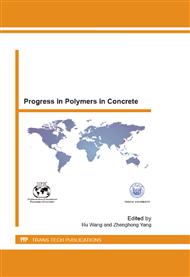p.150
p.155
p.161
p.166
p.175
p.185
p.191
p.198
p.204
Bond Strength of Polymer Cement Slurry-Coated Rebar Using EVA Latex in Cement Concrete
Abstract:
Polymer cement slurry(PCS) made from organic polymer dispersion and cement has good adhesion to steel, waterproofness and acid resistance due to being of polymer films formed in the cement slurry. The purpose of this study is to evaluate the mix conditions such as coating thicknesses, curing ages and polymer-cement ratios of PCS-coating material effected on improvement in bond strength of rebar coated by PCS with EVA latex in cement concrete. The test pieces are prepared with four types of polymer-cement ratio, four types of coating thickness and four types of curing age, and tested for the bond strength test. From the test results, in general, bond strength of PCS-coated rebar is better than that of uncoated rebar and epoxy-coated rebar. It is also high bond strength at curing ages of 7-day or less, and coating thicknesses of 75 µm and 100 µm. The maximum bond strength of PCS-coated rebar at curing age of 3-hour is almost same as that of curing age of 1-day and 7-day. The maximum bond strength of PCS-coated rebar with EVA at polymer-cement ratio of 50%, and coating thickness of 100 µm is about 1.41 and 1.47 times respectively, the strength of uncoated rebar and epoxy-coated rebar. It is apparent that the curing age, coating thickness and polymer-cement ratio are very important factors to improve the bond strength of PCS-coated rebar to cement concrete. We can have basic information that it can replace epoxy coated rebar by the PCS-coated rebar with curing age at 3-hour and coating thickness of 100 µm.
Info:
Periodical:
Pages:
175-184
Citation:
Online since:
April 2013
Authors:
Price:
Сopyright:
© 2013 Trans Tech Publications Ltd. All Rights Reserved
Share:
Citation:


